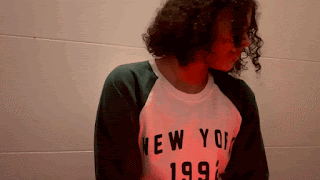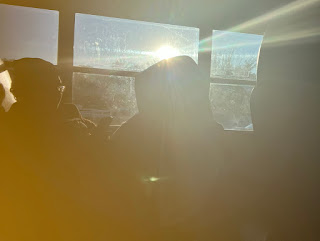Creative Critical Reflection
1. How does your project challenge conventions AND how does it represent social groups or issues?
My project challenges conventions within media by displaying themes of mental health and depression. Additionally, while indie artists' music videos are often low budget, its not often you see an entire music video shot in a single setting, with a single actor, and a single person creating the whole thing. Throughout my music, the main character is shown experiencing feelings of depression as she ages. This goes against the norm because mental health is often an overlooked and taboo subject, especially within music videos, where the goal is to most usually entertain in a positive way. Another way it represents social groups is by featuring a woman of color as it's main subject. It's no secret the music industry white-dominated, so having someone of color isn't as common and this music video serves as representation for that issue.
2. How does your project engage with audiences AND how would it be distributed as real media text?
This is music video, which are usually created to help viewers envision and further connect with a song and its message. My video specifically does this by interpreting the lyrics to Clairo's "Sinking" and connecting them to the theme of mental health and growing older, feeling the need to stay in your youth forever. This connects with audience member's who are going through similar feelings: who will feel represented and heard in a piece of media like this. It would be distributed as a music video, uploaded to the popular video streaming app like YouTube. Music videos are often a way for artists to not only artistically express themselves, but to promote their music video to consumers. Viewers watch these music videos to these songs, and are later inclined to keep listening without watching. That would mean that this video wouldn't only serve as a work of art, but also an advertisement for people to purchase and stream the song used.
3. How did your production skills develop throughout this product?
Because this project was filmed entirely by myself, with myself as the on only actor, I had to work around a lot of obstacles to make filming work. For one, the amount of different makeshift tripods I had to use was unreal! For example, the first few shots, I needed action shots of me doing things, but also filmed at the proper angles, which took a lot of maneuvering my "tripod" (stacks of books and various objects) to get the angle needed, a more downward shot. I also discovered camera tricks to get a more proper look to the video. One of these was the "cinematic" mode on the iPhone camera app, which I learned directed light and focus in a way to make shots look more professional. Additionally, I learned the best ways to film as to get the best lighting. Almost all shots were taken on one side of my set, because I discovered that the direct light illuminated shots and made the video look bright and crisp. On a smaller level, there were a few shooting techniques I created throughout the filming process that I will consider using in future projects. One of these was to film facing a window or source of light. This made the shot enveloping, as the main subject appears blacked out while the whole background is illuminated. Lastly there was editing. My video featured many zooms, as-well as Timelapses, which I all achieved through trial and error in my editing software.
4. How did you integrate technologies - software, hardware, and online - in this project?
My main integration of technology was my use of editing software. The software I selected to use this project was the video editing app InShot. Because I was most familiar with it from last project I initially thought it would be best to use. However, later in the project I discovered I couldn't do a zoom animation to a clip. After downloading the app CapCut to do this one minscule task, I learned that this other app is much more effective in video editing. There are many more features to utilize, as well as a more user friendly interface that made the process much easier. Another technology I used was the music itself. In my research, I spent hours on the online website Youtube, watching and researching a multitude of music videos in preparation. I then screen recorded the lyric video to Clairo's "Sinking", and used InShot's "extract audio from video feature" to insert the song into my project. When I realized the section of lyrics I wanted to film to was over the time limit, I used another InShot feature to speed up the song by 1.20. This turned out to be the best last minute choice I've made and drastically improved my project. Previously, the slow song was a little to drawn out and monotonous. But with the speed, the video became much more lively and easier to keep up with. Lastly, a hardware technology I used was my phone for filming. It was during this project I discovered so many ways to use the iPhone camera to it's full potential, by adjusting different settings and using the cinematic preset. The end result, an excellent video where I feel all my weeks of work payed off.




Comments
Post a Comment